
Helen Beatrix Potter was an English writer, illustrator, natural scientist, and conservationist. She is best known for her children's books featuring animals, such as The Tale of Peter Rabbit, which was her first commercially published work in 1902. Her books, including 23 Tales, have sold more than 250 million copies. An entrepreneur, Potter was a pioneer of character merchandising. In 1903, Peter Rabbit was the first fictional character to be made into a patented stuffed toy, making him the oldest licensed character.

Renée Kathleen Zellweger is an American actress. The recipient of various accolades, including two Academy Awards, two British Academy Film Awards, and four Golden Globe Awards, she was one of the world's highest-paid actresses by 2007.

Peter Rabbit is a fictional animal character in various children's stories by English author Beatrix Potter. A mischievous, adventurous young rabbit who wears a blue jacket, he first appeared in The Tale of Peter Rabbit in 1902, and subsequently in five more books between 1904 and 1912. The six books by Potter featuring Peter Rabbit have sold over 150 million copies. Spin-off merchandise includes dishes, wallpaper, painting books, board games and dolls. In 1903, Peter Rabbit was the first fictional character to be made into a patented stuffed toy, making him the oldest licensed character.
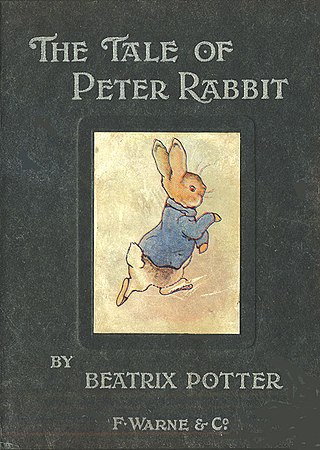
The Tale of Peter Rabbit is a children's book written and illustrated by Beatrix Potter that follows mischievous and disobedient young Peter Rabbit as he gets into, and is chased around, the garden of Mr. McGregor. He escapes and returns home to his mother, who puts him to bed after offering him chamomile tea. The tale was written for five-year-old Noel Moore, the son of Potter's former governess, Annie Carter Moore, in 1893. It was revised and privately printed by Potter in 1901 after several publishers' rejections, but was printed in a trade edition by Frederick Warne & Co. in 1902. The book was a success, and multiple reprints were issued in the years immediately following its debut. It has been translated into 36 languages, and with 45 million copies sold it is one of the best-selling books in history.

The Tale of The Flopsy Bunnies is a children's book written and illustrated by Beatrix Potter, and first published by Frederick Warne & Co. in July 1909. After two full-length tales about rabbits, Potter had grown weary of the subject and was reluctant to write another. She realized however that children most enjoyed her rabbit stories and pictures, and so reached back to characters and plot elements from The Tale of Peter Rabbit (1902) and The Tale of Benjamin Bunny (1904) to create The Flopsy Bunnies. A semi-formal garden of archways and flowerbeds in Wales at the home of her uncle and aunt became the background for the illustrations.
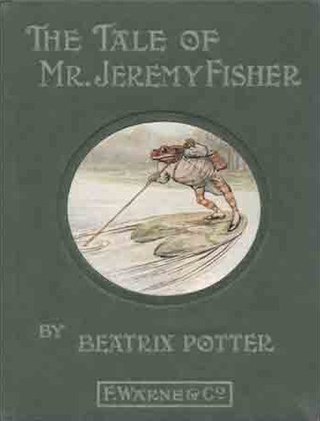
The Tale of Mr. Jeremy Fisher is a children's book, written and illustrated by Beatrix Potter. It was published by Frederick Warne & Co. in July 1906. Jeremy's origin lies in a letter she wrote to a child in 1893. She revised it in 1906, and moved its setting from the River Tay to the English Lake District. The tale reflects her love for the Lake District and her admiration for children's illustrator Randolph Caldecott.

The Tale of Mrs. Tittlemouse is a book written and illustrated by Beatrix Potter and first published by Frederick Warne & Co. in 1910. The book tells the story of a wood mouse named Mrs. Thomasina Tittlemouse and her efforts to keep her house in order, despite the appearance of uninvited visitors. A particularly annoying visitor for Mrs Tittlemouse is Mr. Jackson, a sloppy toad.
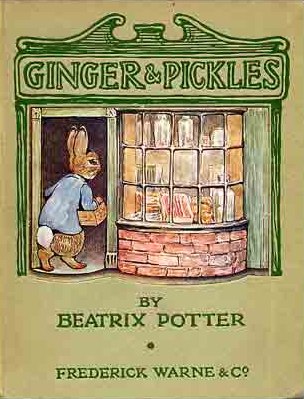
The Tale of Ginger and Pickles is a children's book written and illustrated by Beatrix Potter, and first published by Frederick Warne & Co. in 1909. The book tells of two shopkeepers who extend unlimited credit to their customers and, as a result, are forced to go out of business. It was originally published in a large format which permitted very detailed illustrations and also allowed Potter to include black-and-white vignettes. Potter filled the tale with characters from her previous books. The book was eventually republished in the standard small format of the Peter Rabbit series and was adapted to drama in 1931.
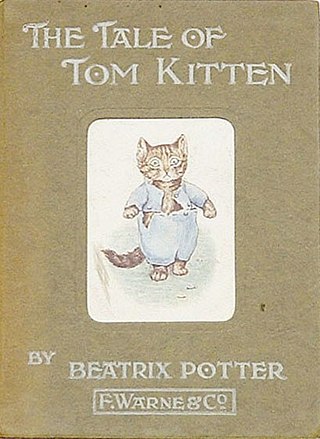
The Tale of Tom Kitten is a children's book, written and illustrated by Beatrix Potter. It was released by Frederick Warne & Co. in September 1907. The tale is about manners and how children react to them. Tabitha Twitchit, a cat, invites friends for tea. She washes and dresses her three kittens for the party, but within moments the kittens have soiled and lost their clothes while scampering about the garden. Tabitha is "affronted". She sends the kittens to bed, and tells her friends the kittens have the measles. Once the tea party is underway however, its "dignity and repose" are disturbed by the kittens romping overhead and leaving a bedroom in disorder.
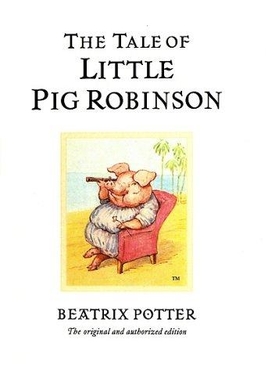
The Tale of Little Pig Robinson is a children's book written and illustrated by Beatrix Potter as part of the Peter Rabbit series. The book contains eight chapters and numerous illustrations. Though the book was one of Potter's last publications in 1930, it was one of the first stories she wrote.
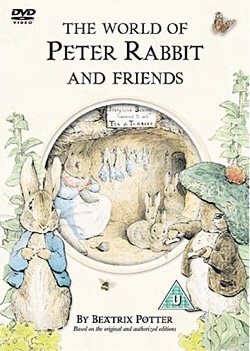
The World of Peter Rabbit and Friends is a British animated anthology television series based on the works of Beatrix Potter, featuring Peter Rabbit and other anthropomorphic animal characters created by Potter. 14 of Potter's stories were adapted into 9 films, and the series was originally shown in the U.K. on the BBC between 20 December 1992 and 25 December 1998. It was subsequently broadcast in the U.S. on Family Channel between 23 October 1992 and 23 October 1995. For the initial VHS releases, some of the characters' voices were dubbed-over by actors with more American-like accents.
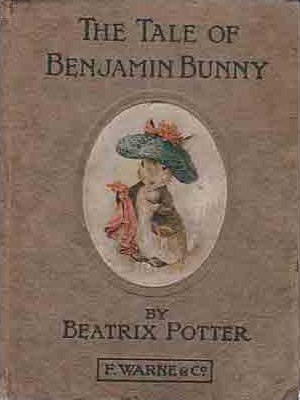
The Tale of Benjamin Bunny is a children's book written and illustrated by Beatrix Potter, and first published by Frederick Warne & Co. in September 1904. The book is a sequel to The Tale of Peter Rabbit (1902), and tells of Peter's return to Mr. McGregor's garden with his cousin Benjamin to retrieve the clothes he lost there during his previous adventure. In Benjamin Bunny, Potter deepened the rabbit universe she created in Peter Rabbit, and, in doing so, suggested the rabbit world was parallel to the human world but complete and sufficient unto itself.

The Tale of Two Bad Mice is a children's book written and illustrated by Beatrix Potter, and published by Frederick Warne & Co. in September 1904. Potter took inspiration for the tale from two mice caught in a cage-trap in her cousin's home and a doll's house being constructed by her editor and publisher Norman Warne as a Christmas gift for his niece Winifred. While the tale was being developed, Potter and Warne fell in love and became engaged, much to the annoyance of Potter's parents, who were grooming their daughter to be a permanent resident and housekeeper in their London home.

The Story of Miss Moppet is a tale about teasing, featuring a kitten and a mouse, that was written and illustrated by Beatrix Potter, and published by Frederick Warne & Co for the 1906 Christmas season. Potter was born in London in 1866, and between 1902 and 1905 published a series of small-format children's books with Warne. In 1906, she experimented with an atypical panorama design for Miss Moppet, which booksellers disliked; the story was reprinted in 1916 in small book format.

The Story of A Fierce Bad Rabbit is a children’s book written and illustrated by Beatrix Potter, and first published by Frederick Warne & Co. in December 1906. The book tells of a bad little rabbit who forcefully takes another rabbit's carrot, but soon loses his tail and whiskers after being fired upon by a hunter. The book was intended for babies and very young children, and was originally published on a strip of paper that folded into a wallet and was tied with a ribbon. The format was unpopular with booksellers, and eventually reprinted in the standard small book format of the Peter Rabbit library. Although the book sold well, there are not many left in existence. It provides the young child with an introduction to books and the Peter Rabbit universe.

The Tale of Pigling Bland is a children's book written and illustrated by Beatrix Potter and first published by Frederick Warne & Co. in 1913. The story describes the adventures of the pig of the title and how his life changes upon meeting a soulmate, in much the same way that Potter's life was changing at the time the book was published.

Frederick Warne & Co. is a British publisher founded in 1865. It is known for children's books, particularly those of Beatrix Potter, and for its Observer's Books.

Norman Dalziel Warne was the third son of publisher Frederick Warne, and joined his father's firm Frederick Warne & Co as an editor. In 1900, the company rejected Beatrix Potter's The Tale of Peter Rabbit, but eventually reconsidered and in October 1902, published the book to great success. Norman Warne became Potter's editor and they worked together on several subsequent books and related merchandise, such as soft toys and The Game of Peter Rabbit.

Ewan Gordon McGregor is a Scottish actor. His accolades include a Golden Globe Award and a Primetime Emmy Award. In 2013, he was appointed Officer of the Order of the British Empire (OBE) for his services to drama and charity.
Justin McDonald is a British actor of film, television and theatre.



















